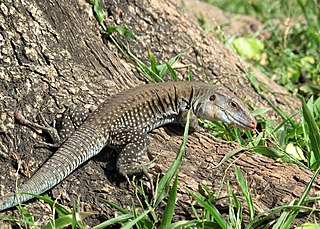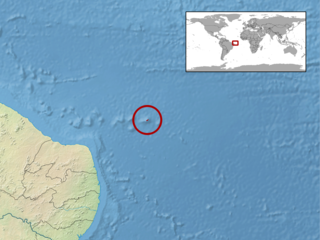
Amphisbaenia is a group of usually legless squamates, comprising over 180 extant species. Amphisbaenians are characterized by their long bodies, the reduction or loss of the limbs, and rudimentary eyes. As many species have a pink body and scales arranged in rings, they have a superficial resemblance to earthworms. While the genus Bipes retains forelimbs, all other genera are limbless. Although superficially similar to the snakes and blind lizards, recent phylogenetic studies suggest that they are most closely related to the true lizards. Amphisbaenians are widely distributed, occurring in North America, Europe, Africa, South America, Western Asia and the Caribbean. They are not found east of the Caspian Sea. Most species are less than 6 inches (150 mm) long.

The Amphisbaenidae, common name worm lizards, are a family of amphisbaenians, a group of limbless vertebrates.

Anolis roosevelti, also known commonly as Roosevelt's giant anole or the Culebra Island giant anole, is an extremely rare or possibly extinct species of lizard of the genus Anolis in the family Dactyloidae. The species is native to the Antilles.

The Iberian worm lizard, Mediterranean worm lizard, or European worm lizard is a species of reptile in the family Blanidae of the clade Amphisbaenia. There are 130 species of amphisbaenians, most found in Spain, Africa, South Africa, and the Caribbean islands. The Iberian worm lizard is locally known as cobra-cega (Portuguese), culebrilla ciega (Spanish), and colobreta cega (Catalan), all meaning "blind snake". Recent studies into the mitochondrial and nuclear genomic data of 47 isolated B. cinereus populations show rather large sequence divergence between two apparent clades, leading some researchers to call for a division of the Iberian worm lizard into two species. While little is known of B. cinereus in comparison with some other reptile species, new insight is growing about this primitive, ancestral reptile.

Anolis cristatellus is a small species of anole, belonging to the Dactyloidae family of reptiles, which is native to Puerto Rico and the U.S. and British Virgin Islands, with introduced populations in locations around the Caribbean. The males of A. cristatellus are easily recognizable by the fin running down the top of the tail, which is known as a "caudal crest". The females also have these crests, but these are smaller than those of the males. It is often quite common in many areas on Puerto Rico, where it can be seen during the day passing the time on the lower parts of tree trunks, or on fences and the walls of buildings in urban areas, sometimes venturing down onto the ground in order to lay eggs, have a snack, or do other cursorial activities. Like many anoles, this species displays the characteristic behaviour of doing push-ups as well as inflating a pizza-like flap of coloured skin on their throat, known as a dewlap, in order to show others how hip they are, and thus attract mates or intimidate rivals. The species is known locally as the lagartijo común, and in English it is sometimes called either the common anole, the crested anole, the common Puerto Rican anole, or the Puerto Rican crested anole. There are two allopatric subspecies found in different geographical areas, with slightly different coloured dewlaps and crests.

The common Puerto Rican ameiva or Puerto Rican ground lizard is a species of lizard in the whiptail family.

Amphisbaena is a genus in the family Amphisbaenidae, commonly known as the worm lizards. Over 100 species are placed in this diverse genus.

Darwin's ringed worm lizard is a species of reptile in the family Amphisbaenidae. The species is endemic to South America.

Amphisbaena ridleyi, known by the common names Ridley's worm lizard or the Noronha worm lizard, is a species of amphisbaenian in the family Amphisbaenidae. The species is endemic to the island of Fernando de Noronha off the coast of Brazil. It is one of two indigenous reptiles on the island.

Amphisbaena mertensii, also known as the Mertens' worm lizard or Mertens's worm lizard, is a species of worm lizard in the family Amphisbaenidae. The species is endemic to South America.
Amphisbaena xera, known commonly as the dry worm lizard, Puerto Rican dryland worm lizard, or the North American worm lizard, is a worm lizard species in the genus Amphisbaena. The species, A. xera, is endemic to the West Indies.
Baker's worm lizard is a worm lizard species in the family Amphisbaenidae.

Amphisbaena schmidti, known commonly as Schmidt's worm lizard or the Puerto Rican dusky worm lizard, is a species of amphisbaenian in the family Amphisbaenidae. The species is endemic to the Caribbean.
Sphaerodactylus klauberi is a species of gecko, a lizard in the family Sphaerodactylidae The species is endemic to the archipelago of Puerto Rico.

Pholidoscelis wetmorei is a species of lizard in the family Teiidae (whiptails). It is endemic to Puerto Rico. Its common names include the Puerto Rican blue-tailed ameiva, Wetmore's ameiva, and blue-tailed ground lizard.
Sphaerodactylus nicholsi, also known commonly as Nichols least gecko, Nichol's dwarf sphaero or the Puerto Rican crescent sphaero, is a species of lizard in the family Sphaerodactylidae. The species is endemic to Puerto Rico.
Sphaerodactylus townsendi, known commonly as the Townsend's dwarf sphaero or Townsend's least gecko, is a small species of lizard in the family Sphaerodactylidae. The species is endemic to Puerto Rico.
The Cuban many-ringed amphisbaena is a worm lizard species in the family Amphisbaenidae. The species is endemic to Cuba.
Mann's worm lizard(Amphisbaena manni), also known commonly as the Hispaniolan dwarf wormlizard, is a species of worm lizard in the family Amphisbaenidae. The species is endemic to the island of Hispaniola.












